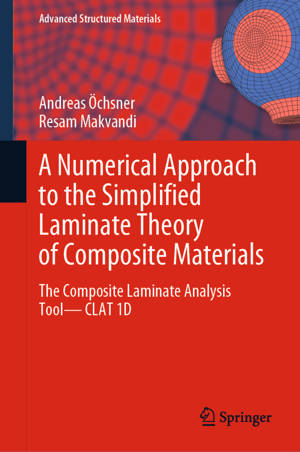
- Retrait gratuit dans votre magasin Club
- 7.000.000 titres dans notre catalogue
- Payer en toute sécurité
- Toujours un magasin près de chez vous
- Retrait gratuit dans votre magasin Club
- 7.000.0000 titres dans notre catalogue
- Payer en toute sécurité
- Toujours un magasin près de chez vous
A Numerical Approach to the Simplified Laminate Theory of Composite Materials
The Composite Laminate Analysis Tool--Clat 1d
Andreas Öchsner, Resam MakvandiDescription
A typical approach to treat composite materials, which are composed of layered unidirectional lamina, is the so-called classical laminate theory (CLT). This theory is based on the theory for plane elasticity elements and classical (shear-rigid) plate elements under the assumption of orthotropic constitutive equations. The solution of the fundamental equations of the classical laminate theory is connected with extensive matrix operations and many problems require in addition iteration loops.
This two-dimensional approach and the underlying advanced continuum mechanical modeling might be very challenging for some students, particularly at universities of applied sciences. Thus, a reduced approach, the so-called simplified classical laminate theory (SCLT), has been recently proposed. The idea was to use solely isotropic one-dimensional elements, i.e., a superposition of bar and beam elements, to introduce the major calculation steps of the classical laminate theory. Understandingthis simplified theory is much easier and the final step it to highlight the differences when moving to the general two-dimensional case.
This monograph first provides a systematic and thorough introduction to the simplified laminate theory based on the theory for bars and classical beam plate elements. The focus is on stacking of isotropic layers to simplified laminates. In addition to the elastic behavior, failure is investigated based on the maximum stress, maximum strain, Tsai-Hill, and the Tsai-Wu criteria. We provide a Python-based computational tool, the so-called Composite Laminate Analysis Tool (CLAT 1D) to easily solve some standard questions from the context of fiber reinforced composites. The tool runs in any standard web browser and offers a user-friendly interface with many post-processing options. The functionality comprises stress and strain analysis of simplified lamina and laminates and the failure analysis based on different criteria.
Spécifications
Parties prenantes
- Auteur(s) :
- Editeur:
Contenu
- Nombre de pages :
- 146
- Langue:
- Anglais
- Collection :
- Tome:
- n° 202
Caractéristiques
- EAN:
- 9783031479830
- Date de parution :
- 12-02-24
- Format:
- Livre relié
- Format numérique:
- Genaaid
- Dimensions :
- 232 mm x 150 mm
- Poids :
- 408 g

Les avis
Nous publions uniquement les avis qui respectent les conditions requises. Consultez nos conditions pour les avis.






